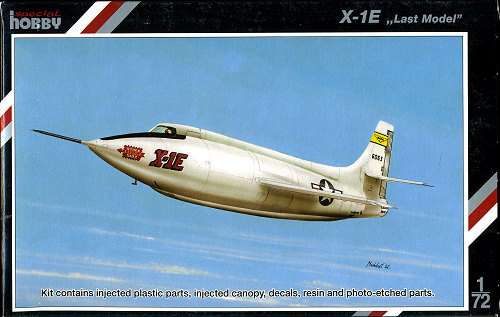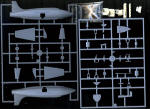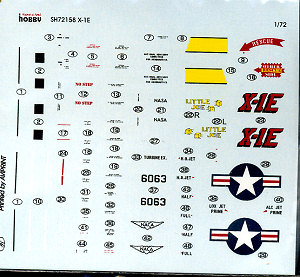
| KIT: | Special Hobby 1/72 X-1E |
| KIT #: | 72158 |
| PRICE: | 21.65 from www.greatmodels.com |
| DECALS: | Five options |
| REVIEWER: | Scott Van Aken |
| NOTES: | Includes resin and photo etched parts |

| HISTORY |
The X-1E resulted from a significant reconstruction of the X-1-2 (s/n 46-063) in order to pursue the goals originally set out for the X-1D and X-1-3, both lost in explosions in 1951.
The changes included:
The X-1E first flew on 15 December 1955, a glide flight under the controls of USAF test-pilot Joe Walker. Walker left the X-1E program in 1958, after 21 flights, attaining a maximum speed of Mach 2.21 (752 m/s, 2,704 km/h).. NACA research pilot John B. McKay took his place in September 1958, completing five flights in pursuit of Mach 3 (1,021 m/s, 3,675 km/h). before the X-1E was permanently grounded following its 26th overall flight, in November 1958, due to the discovery of structural cracks in the fuel tank wall.
This aircraft was a survivor and is now placed on a pole at the entrance to NASA Dryden on Edwards AFB.
| THE KIT |
 Nice to see Special Hobby doing X-planes and equally nice to see that they've chosen the X-1E for one of their subjects. This kit is quite typical of MPM/Special Hobby, with two injected styrene sprues that have nicely engraved detailing. A small bag of resin parts, a small photo etch fret and a clear canopy with surround make up the bits.
Nice to see Special Hobby doing X-planes and equally nice to see that they've chosen the X-1E for one of their subjects. This kit is quite typical of MPM/Special Hobby, with two injected styrene sprues that have nicely engraved detailing. A small bag of resin parts, a small photo etch fret and a clear canopy with surround make up the bits.
Resin is used for the main wheel wells, seat, exhaust nozzles, camera housing and a few other sundry items. The etched fret (not shown) is basically interior stuff like rudder pedals and harness as well as gear oleo scissors and door hinges. The usual.
The kit itself is not complex and since Special Hobby has progressed quite a bit from its early days, construction should not be the challenge it used to be. Most of the parts are butt join as they've not quite reached the stage where they feel comfortable providing alignment pins and slots. As there are a number of different variants (like all X-planes the design changed during its life), Special Hobby has provided the bits and pieces needed. Means that you should decide at a relatively early part of the construction sequence as to which one to do.
Instructions are well done, though I did notice a few numbering glitches. Nothing that is earth-shaking but you do need to verify parts before cementing. Color information is via Gunze and XtraColor, and generic colors. Basically white with unpainted aluminum control surfaces. The markings charts are twice the size as usual and provide options for the aircraft at five times during its life span. The more adventurous will want to do the plane as it was late in life with all the various additional bits, while those who want a smoother looking plane will gravitate towards its earlier incarnations. Decals are well printed and should provide no surprises.
| CONCLUSIONS |
You know you want one. It is just too cool not to have in your collection.
| REFERENCES |
You can get this kit and many others at GreatModels. Click on the link to start your browsing.
January 2008
If you would like your product reviewed fairly and fairly quickly, please contact the editor or see other details in the Note to Contributors.